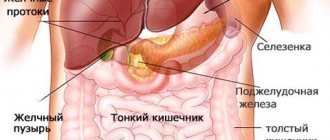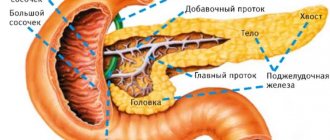The stomach is the main organ of the digestive system, thanks to which active digestion of food occurs. If there are disturbances in its functioning, various complications arise that affect not only other organs of the gastrointestinal tract, but also the entire body as a whole. In order to accurately understand that a person is worried about stomach pain, you need to know where the stomach is and the main functions of the organ.
Where is the human stomach located?
The stomach is an organ located in the abdominal cavity directly below the diaphragm. Most of it is located on the left hypochondrium, the smaller part is in the epigastric zone. This is the epigastric region located under the sternum.
To better understand where the human stomach is located (photo below), you need to consider its location relative to other organs. On the right, its anterior region is covered by the liver. Its small part is adjacent to the abdominal wall. On the left it is slightly covered by the diaphragm.
Adjacent to the posterior wall of the stomach:
- pancreas;
- upper pole of the left kidney;
- adrenal.
Also located to the left behind the organ is the spleen.
Reliable fixation of the stomach is ensured by its ligaments, the tone of the anterior abdominal wall, as well as the transition in the esophageal opening of the diaphragm.
The human stomach is located just below the diaphragm, just below the lungs and heart, and is in contact with the pancreas, liver, spleen and colon. Its upper part is protected by the chest. The organ's shape resembles a J-shaped empty leather pouch, consisting of several layers of muscle that move with force to thoroughly mix the food before entering the duodenum.
Anatomical structure
The stomach has two openings: the inlet - cardia or cardiac, and the outlet - pylorus or pylorus. They are both circular muscles called sphincters that open and close as needed. The cardia connects the esophagus to the stomach, regulates the flow of chyme and prevents reflux. The pylorus connects the organ with the duodenum.
The body of the stomach is its most powerful part, which is anatomically called the lesser and greater curvature. Its walls consist of different layers: mucous membrane, submucosal, muscle and serous tissue. Muscular – the one that helps form a bolus. The fundus of the stomach, its highest part, is located on the left under the diaphragm. This is where gases accumulate. And the antrum or antrum is a narrow area that is located in front of the pylorus.
The stomach is smooth on the outside, wrinkled on the inside. Its inner membrane has small pores, which are the openings of the glands. They secrete gastric juice - a liquid containing hydrochloric acid, pepsin, gastrin and lipase. All these compounds are necessary for the high-quality digestion of carbohydrates, proteins and fats, the absorption of nutrients from them and their absorption into the blood.
Structure
The organ can be called part of the digestive tract chain and, undoubtedly, its most important link. It is located in front of the duodenum and, in fact, is a continuation of the esophagus. The stomach and the anatomy of the tissues lining its walls are composed of: mucous, submucosal, muscular and serous membranes.
The mucous membrane is the place where acid is produced and secreted.
The submucosa is a layer composed of connective tissue that separates the mucosa from the muscular outer surface.
Muscle - consists of fibers, which are divided into several types, named according to their location in the organ. These are the inner oblique layer, the middle circulation layer and the outer longitudinal layer. All of them are involved in uniform mixing and grinding of food, as well as its further movement along the tract.
The final layer, serosa, is a connective tissue that lines the outer walls of the stomach and prevents it from sticking to neighboring organs.
Behind the organ is the pancreas and the greater omentum. The main areas of the stomach structure and anatomy consist of: the esophageal sphincter (cardiac sphincter), fundus, body, antrum (pyloric) and pylorus. In addition, it has a major curvature (posterior convex part) and a lesser curvature (anterior concave part), which are located on the left and right sides, respectively. The esophageal sphincter is located in the cardiac region and controls the flow of material into the stomach. The bottom is its upper section, the wall of which is formed by the superior curvature, and the body represents the main area of the organ. The final part is the antrum, serves as the exit and entrance to the small intestine and ends with the pyloric sphincter (pylorus).
Functions
The main functions for which the stomach is responsible include:
- The main depot for incoming food. In the process of eating food, it is the stomach that takes on the role of a “station” that holds the bolus of food, which allows a person not to feel hungry for a certain time.
- In the stomach, mechanical processing of incoming food is carried out, that is, it is mixed with gastric juice, which turns it into a liquid mass.
- Thanks to special enzymes contained in the organ, the initial stage of breakdown of proteins, fats and carbohydrates occurs.
- Thanks to the peristalsis of the stomach, food moves further into the duodenum.
- It is in the stomach that most of the pathogenic bacteria that enter the body with food are destroyed.
- This is where nutrients begin to enter the bloodstream after digestion begins.
Thanks to the implementation of all these functions, the functioning of all body systems is normalized.
Basic functions of the stomach
It is not for nothing that this organ is often called the main organ of the digestive system - the quality and quantity of food entering the intestines will depend on its proper functioning. This organ performs a number of important functions for the body:
- Initial digestion. Processing, grinding and digesting food.
- Disinfection. This is an important bactericidal function of the stomach. Thanks to hydrochloric acid coming from various glands, harmful bacteria that can enter the body with food are eliminated.
- Cumulative function. Processed food remains for some time in the space of the stomach, where it is processed.
- Pushing food. This is a purely mechanical process that helps move food further along the digestive tract.
- Chemical processing of food is necessary for the normal absorption of elements necessary for the body.
- Excretion is, at its core, a replacement for renal function. It is extremely useful if the kidneys cannot fully do their job.
- Production of Castle factor - a necessary element in order to absorb the necessary element B12 from food.
- Endocrine function. The stomach is surrounded by a large number of glands that perform different functions. Among them is the release of secretions and hormones necessary for the body, which affect not only the human digestive system.
Thus, the stomach is an extremely multifunctional and complex organ that is extremely necessary for the human body.
Sections of the stomach
The human stomach consists of different sections, each performing its own function. Let's take a closer look at each progression of food.
Cardiac region of the stomach
As its name suggests, this section of the stomach is somehow connected to the heart. This is true: it is located close to the heart muscle. When it comes to moving food, the cardiac section of the stomach is located first - through it food passes to other sections. At the base of this section of the stomach is the upper gastric house, the main function of which is to prevent food from entering back into the esophagus.
If the stomach is full or the food in it is digested extremely slowly, then heartburn occurs - this is the release of already partially digested food through the house. In this section of the stomach, food is not particularly retained or processed - it is simply transported to other gastric sections.
Fundus of the stomach
Despite its name, this section of the stomach is not located at the bottom. It is a convex part of the stomach, very similar to a dome in shape. This section contains many glands that help with the breakdown of food. A large amount of hydrochloric acid comes from this department. It is necessary primarily as a bactericidal agent that disinfects incoming food.
Body of stomach
This section of the stomach is in fact the largest. Once in this section, food is digested thanks to the secretions of glands similar to the glands of the fundus of the stomach: hydrochloric acid, mucus, etc. This section of the stomach most often suffers from various gastric diseases. The body of the stomach also contains two curvatures: greater and lesser. The small one is located at the top, and the large one at the bottom.
They provide the stomach with its peculiar asymmetrical shape. Both curvatures are attached to a special connective tissue called the omentum. Its function is to protect the main digestive organ from external mechanical damage.
Antrum of the stomach
It is also called the antrum. It is located at the end, closer to the duodenum. Food enters it already in a sufficiently processed and digested form, so the main task of this part of the organ is to mix food, grind it even more and push it through the sphincter towards the duodenum. The antrum of the stomach also contains a number of glands, which are called antral glands. They produce mucus, which is necessary to neutralize too strong hydrochloric acid.
After passing through this section, food continues to be digested, but in a more alkaline environment. Thus, in this part of the stomach, neutralizing, endocrine and mechanical functions take place, which are essential for the digestion of food. There is no clear boundary between the transition from the body of the stomach to the antrum; it is shown approximately schematically.
The functions of this section of the stomach are quite specific; if any of them is disrupted, diseases can occur. If food is not completely digested, or moves too slowly, then it stagnates in the antrum. Stagnation, fermentation and other unpleasant processes may also occur in it.
Pyloric part of the stomach
It is preceded by the so-called prepyloric section of the stomach. This section is also called the pylorus of the stomach. According to the movement of food, it is considered to be the last section of the stomach; food immediately after it enters the sphincter. It also applies to this department. Its main function is to prevent undigested food from entering the intestines. It has a rather narrow structure in comparison with other parts of the main digestive organ.
Stomach shape
The shape of the pylorus of the stomach resembles an oval, which tapers towards the duodenum. Residual digestion of food occurs in it, but it also performs a number of other functions. It accumulates a bolus of food before moving into the intestines.
During accumulation, further processing of food occurs. It also produces Castle factor, which is responsible for the absorption of vitamin B12 into the body. It also promotes the mechanical movement of already sufficiently processed food further down the digestive tract.
As the picture showed, the stomach has a peculiar shape. However, each person may have an individual form, similar in general terms to the image. This depends on the internal arrangement of other organs located in the abdominal cavity. Conventionally, there are three main forms of the stomach:
- Horn - with this shape, the stomach has low levels of bending and most often gradually tapers from the cardia to the pylorus. Most often, this configuration is found in people with a short torso.
- Hook - in this case, the curves of the stomach, on the contrary, are clearly pronounced and the sections are located almost at right angles to each other. People of average height and weight often have this stomach shape.
- Stocking - this form of the stomach is characterized by its almost vertical location. Most often, this form is characteristic of thin and long people.
The shape of the stomach does not have much effect on the quality of food digestion.
Projection of the stomach on the body
The organ is located in the left hypochondrium near the midline. If we translate it into simpler language, it turns out that the stomach is located under the ribs on the left on the front surface of the abdomen. First, let’s decide how to determine the location of the stomach on the surface of the body, that is, we’ll figure out the projection of the organ.
It should also be taken into account that part of the stomach is covered by the ribs. Sometimes it is necessary to know the exact location of individual anatomical parts of the stomach to clarify the localization of pain.
- The cardiac section is located 2-3 centimeters to the left of the edge of the sternum at the level of the xiphoid process, that is, along the lowest edge of the sternum.
- The fundus and body of the stomach are located slightly to the left of the midline of the abdomen, 1-2 centimeters below the sternum.
- The pyloric region is located 2-3 centimeters to the right of the midline of the abdomen, 2-3 centimeters below the sternum.
It must be remembered that the stomach filled with food is somewhat displaced from the indicated landmarks.
Possible displacements of the human stomach
Gastric displacements are quite common, and they are varied. They may occur in the following cases:
- When exposed to a tumor or cyst located in nearby tissues
- In a situation where the liver or spleen is enlarged
- In a situation of swelling of the transverse intestine (colon)
- Changes in patient diaphragm position
- With perigastritis (this is an inflammatory process affecting the serous covering of the stomach itself)
I would especially like to highlight the question of where a pregnant woman’s stomach is located. Often, during pregnancy, a woman may experience discomfort and pain in the stomach area. This is due to changes in bacteriological as well as hormonal levels. In addition, there is a smooth displacement of the stomach and other peritoneal organs. The stomach takes a position close to the costal margin. This factor reduces its volume. However, a pregnant woman's appetite increases. All this can lead to pain in a pregnant woman. With such a displacement of the stomach, a woman needs to eat in small fractional portions.
Secretory function. Stomach glands
The secretory function of the stomach is to chemically process the bolus of food using the secretion produced. An adult produces from one to one and a half liters of gastric juice per day. It contains hydrochloric acid and a number of enzymes: pepsin, lipase and chymosin.
Glands are located on the entire surface of the mucosa. They are exocrine glands that produce gastric juice. The functions of the stomach are directly related to this secretion. Glands are divided into several types:
- Cardiac. They are located in the cardia area near the entrance to this organ. These glands produce a mucoid mucus-like secretion. It performs a protective function and serves to protect the stomach from self-digestion.
- Main or fundic glands. They are located in the area of the fundus and body of the stomach. They produce gastric juice containing pepsin. Due to the juice produced, the food mass is digested.
- Intermediate glands. Located in the narrow intermediate zone of the stomach between the body and the pylorus. These glands produce a viscous mucoid secretion, which has an alkaline reaction and protects the stomach from the aggressive effects of gastric juice. It also contains hydrochloric acid.
- Pyloric glands. Located in the gateway area. The secretion they produce also plays a protective role against the acidic environment of gastric juice.
The secretory function of the stomach is provided by three types of cells: cardiac, fundic, or main, and pyloric.
Neighboring organs
The anatomy of the human stomach is inextricably linked with the condition of neighboring organs. Therefore, it is important for a doctor to know the topography; we can call it a “3D vision” of connections with neighboring organs. The anterior surface of the stomach is partially adjacent to the diaphragm, the abdominal wall and the lower edge of the liver.
The posterior surface is in contact with the pancreas, aorta, spleen, the upper part of the left kidney with the adrenal gland, and partially with the transverse colon. The dense “neighborhood” is reinforced by nutrition from the same arterial branches, joint venous and lymphatic drainage. Therefore, the structure of the human stomach is subject to changes in pathological conditions of other internal organs.
Causes of organ diseases
Abdominal pain has many potential causes. The most common ones—gas pain, stomach upset, or muscle strain—are not serious. Other conditions may require urgent medical attention.
| Causes of acute pain | Causes of episodic pain | Causes of progressive pain |
|
|
|
The cause of pain can also be diseases of the abdominal wall itself. These include hernias and inflammation.
How does the blood supply to the stomach occur?
Arteries that arise from the celiac trunk are responsible for the blood supply to the stomach. The left artery is localized in the retroperitoneal region and passes under the upper part of the pancreas. This vessel is directed to the left and forward. In the cardiac region it is divided into ascending and descending branches.
The right artery arises from the hepatic artery. The gastroepiploic artery, located on the right, begins from the gastroduodenal vessel. The left gastroepiploic artery originates in the region of the spleen. In addition, the posterior fundal branches begin in the area of the splenic artery. The veins accompany arteries with the same names, and they flow into the portal vein.
Common stomach diseases
The most common stomach diseases are:
- gastritis , acute and chronic form;
- erosion;
- stomach ulcer;
- cancer.
In addition, there are dyspeptic disorders (heartburn, belching), developmental pathologies, and deformities caused by scar changes.
What cells provide the function of digesting food?
The structure of the mucous membrane is studied by histologists when diagnosing a pathological process. Normally it includes:
- cells of single-layer columnar epithelium;
- a layer called “intrinsic”, made of loose connective tissue;
- muscle plate.
The second layer contains its own glands, which have a tubular structure. They are divided into 3 subspecies:
- the main ones - produce pepsinogen and chymosin (digestive enzymes, in an acidic environment they turn into proteolytic enzymes);
- parietal (lining) - synthesize hydrochloric acid and gastromucoprotein;
- additional - form mucus.
Among the glands of the pyloric zone are G-cells that secrete the gastric hormonal substance gastrin. Accessory cells, in addition to mucus, synthesize a substance necessary for the absorption of vitamin B12 and hematopoiesis in the bone marrow (Castle factor). The entire surface of the mucosa in the deep layers contains cells that synthesize the precursor of serotonin.
The gastric glands are located in groups, so under a microscope, from the inside, the mucous membrane has a granular appearance with small pits and flat, irregularly shaped fields. The good adaptability of the healthy mucous membrane is noteworthy. It is capable of rapid recovery: the epithelium on the surface is replaced less than every 2 days, and the glandular one - in 2-3 days. A balance is maintained between old cells being rejected and newly formed ones.
In diseases of the stomach, hypertrophy of the glands, inflammation and cell death occur, dystrophic and atrophic disorders are accompanied by a failure in the production of necessary substances, scarring replaces the functioning tissue with non-functioning fibrocytes. Malignant cells transform into atypical ones. They begin to grow and release toxic substances that poison the body.
The secretory activity of the stomach is controlled by nervous and humoral mechanisms. The main influence on the functioning of the organ is exerted by the branches of the sympathetic and vagus nerves. Sensitivity is provided by the receptor apparatus of the wall and spinal nerves.
The structure of the stomach wall
On the outside, the organ is covered with a serous membrane made of a loose connective tissue base and squamous epithelium. From the inside the wall is divided:
- on the mucous membrane;
- submucosal layer;
- muscle layer.
An important feature is the absence of nerve pain receptors in the mucous membrane. They are present only in deeper layers. Therefore, a person feels pain when muscle function is disrupted (spastic contraction or overstretching) or the pathological process, bypassing the mucous membrane, moves into the depths (with erosions, ulcers).
Where does your stomach hurt? Causes of pain
The reasons for stomach discomfort may be physiological or pathological. It happens that the pain is present for a certain period of time, and then goes away. Where the stomach hurts is also a determining indicator.
The person experiences relief and continues to ignore such unpleasant sensations. This behavior is erroneous. Since this type of pain may indicate that there is a serious disease in the human body that needs to be treated urgently.
Gastritis
What pathological processes can cause stomach pain? For example, it could be gastritis. Where does the stomach hurt with gastritis? This disease is characterized by the fact that its walls become inflamed. With gastritis, the pain is intermittent. It occurs after a person has eaten foods that cause irritation to the inflamed walls of the stomach.
If gastritis occurs in an acute form, then immediately after the patient has eaten a food product that he should not eat, sharp pain occurs in the epigastric region. This discomfort goes away quickly. But it resumes after the next consumption of those foods that cause irritation. When gastritis is chronic, a person does not experience severe pain. In this case, the discomfort is aching in nature. There is also a feeling of fullness and bloating.
Dyspepsia
Another cause of discomfort is dyspepsia. In this case, where does a person’s stomach hurt? This disease has another name, namely, nervous stomach. The pain with this pathology is spastic. In addition, the person begins to feel sick. He also does not want to eat, and there is a feeling that his stomach is full. The pain syndrome is located in the stomach area. But in fact, the cause of its occurrence comes from the pancreas.
Ulcer
Now let's look at the signs and symptoms of a stomach ulcer. Where does it hurt with this disease? A stomach ulcer is the next stage in the development of gastritis in the human body. If the latter ailment is not treated properly, the patient begins to develop an ulcer. Where does it hurt with a stomach ulcer? Since this disease is a consequence of gastritis, this suggests that the person is already accustomed to constant unpleasant sensations. Therefore, he may not pay attention to new ones.
It is worth saying that pain with an ulcer is more severe. They occur immediately after food enters the stomach. A person should pay attention to the severity of the pain. In this case, it is recommended to consult a doctor as soon as possible for qualified help.
Benign tumors and polyps
With such pathologies, pain in the stomach may also occur, where it hurts specifically will be discussed later. These formations in the stomach do not pose any danger to the patient’s life. However, they cause quite uncomfortable sensations. Pain comes when food enters the stomach and comes into contact with tumors, causing them to irritate. Also, when a person has eaten too much food, he begins to experience discomfort in the stomach. With this type of pathology, the pain is aching in nature. The patient also has a feeling of fullness in the abdomen. Moreover, this feeling is present even if the patient has eaten a little food. The discomfort goes away after a short time and ceases to bother the patient.
What is this?
The stomach is a hollow muscular organ, the upper part of the gastrointestinal tract (gastrointestinal tract). It is located between the esophagus tube and the component of the small intestine - the duodenum.
The average volume of an empty organ is 0.5 l (depending on the anatomical features, it can reach up to 1.5 l). After eating, it increases to 1 liter. Some people can stretch up to 4 liters!
The size of the organ will vary depending on the fullness of the stomach and the person’s body type. On average, the length of a full stomach is 25 cm, and that of an empty stomach is 20 cm.
On average, food stays in this organ for about 1 hour. Some food can be digested in only 0.5 hours, some – 4 hours.










